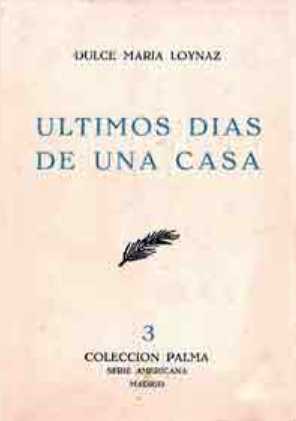4.1.1.16.4 The poem “Last Days of a House”, 1958, Dulce María Loynaz

The poem “Last Days of a House” dates from 1958, a long verse text whose structure is based on the poetic device of personification, of an old mansion soon to be abandoned. The lyrical subject grieves for abandonment, for so much life now slipping away in the shadow of the past, leaving only a persistent dust, a frightening emptiness that is perhaps eternal.
It’s a coincidence that the text was written precisely in 1958, when the end of a way of life was in sight, in which the house stood as a possible symbol of that which must be destroyed in order to build a new order upon its foundations; although this interpretation seems justified only by the year, the imminence of something vague that is feared, along with the instinct to preserve the old, perhaps extrapolated to spheres of meaning that do not adhere to Loynaz’s simple purpose.
On a more straightforward level of reading, we see a kind of transubstantiation of the poet within the living environment of the house, perhaps reminiscent of her home or the fortified confines of her self, threatened by who knows what contingencies. However, the polysemic nature of poetry allows for even contrasting exegeses to coexist, without ignoring the fact that the walls could be the body of the poet’s soul.
The text displays a more pronounced colloquial tone, or rather, a more pronounced desire for language than in previous works, and the lexical simplicity denotes that communication is important per se. Interestingly, from the interpretation of the house as a symbol of the poet’s self, the feeling that her isolation is involuntary, caused by the distancing of others, while she had not abandoned her inner warmth, is evident.
The poem culminates with the following verses:
“Men are, and only they,
those with better clay than mine,
whose greed was stronger
that the need to hold me back.
And I was sold at last,
because I came to be worth so much in their accounts,
that was worthless in his tenderness…
And if I’m not worth anything in it, I’m worth nothing…
And it’s time to die.”
The layout of the house and the objects inside, even the dust that rains down on it, constitute springs that activate memory and through which images of family history parade, reconstructing a time that is no longer linear but, due to the effect of the spatial coexistence of its springs, becomes unique, an anamnesis that one wishes to erase and that can only be annulled with one’s own death.








